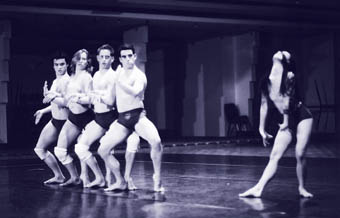Artful devices and the afterlife
Helen Omand: ADT, Nothing

Australian Dance Theatre, Nothing
photo Alex Makayev
Australian Dance Theatre, Nothing
Before 5000 dimly discernible faces in Adelaide’s Botanic Park, the Australian Dance Theatre presented their new work, Nothing. Part of the 10th anniversary of WOMAdelaide. The work by Garry Stewart and dancers continues the company’s commitment to diverse presentations. The electronic soundscape of sound designer Luke Smiles pulsates over the crowd, turning the chilly night air electric with anticipation. Four dancers enter, dropping into a twisted hyperactivity with gargoyle faces while an intricate, powering duet of sweeping angular movement between Roland Cox and Larissa McGowan intersects the space. For 40 minutes the ADT troupe will be adrenalised terpsichorean rock stars.
Paul White crosses the stage with a series of liquid contortions that embody a positively pagan animal magnetism. The sound of breaking glass heralds a quintet whose synchronised movements exude a sense of fragility, of something ‘other.’ Wearing sheer, torso-revealing, underwear, designed by Gaelle Mellis, these creatures look out with trepidation, extending and quickly withdrawing limbs into a personal, protective space. The work continues in a seamless collage of physical arrangements: solo, duet, layered with solemn clan ritualism. Limbs are tossed while idiosyncratic gestures are momentarily suspended by protracted, finitely balanced extensions and gravity defying flight. A vocabulary motivated from internal spaces is a departure from the signature Stewart style. This work unfolds from the inside out as the composition slides in and out of formation, creating space for startling, short dynamo solos by Lena Limosani, Anton and, on a bare stage, sinuous Amazonian flexions from Sarah-Jayne Howard.
Inspired by Sogyal Rinpoche’s Tibetan Book of Living and Dying and Elisabeth Kubler Ross’ On Death and Dying, the work has a reflexive quality, the states-of-being it suggests are ‘not of this world’, but gesture to something past. It’s as if time has reverted to the reptilian dawning of mankind, stretching the tenuous thread between life, death and the hereafter. Nothing is loaded with abstract signs, both in the dance language and in the dancers’ ethnic tattoos. The movement vocabulary is a primal soup of dance history, with borrowings from Ashtanga yoga and gymnastics, reconstituted to create something hybrid and new.
Less esoteric, Artifice by Peter Sheedy was planted firmly in the realms of human behavior and the influence of technology. It was performed at Adelaide’s tertiary dance training institution, the Adelaide Institute of TAFE. Sheedy has danced with many of Australia’s leading companies and has made work for Chrissie Parrott, Leigh Warren and Dancers and Csaba Buday. Artifice is the culmination of 3 years’ development, a fragmented journey of spoken text, contemporary dance and video imagery.
On stage the dancers stand, casually conversing, dropping in and out of pedestrian movement, peering and commenting on audience members as they enter. An industrial atmosphere with dim blue lighting, search lights, slowly rotating gobos and a red light grid create a cold geometric world in which the 4 dancers try to relate. Melissa Jaunay’s lighting dissects the space, delineating areas for actions. Boundaries are tested through physical and verbal play. A series of couplings, solos and trio unison phrases unfold, clearly marked by entrances and exits that highlight the superficiality of attempts to win each other over.
Solon Ulbrich and John Leathart perform a seamless duet of intertwining bodies, manipulating each other to get what they want, suggesting the games people play. Kim Hales McCarthur delights in a hot pink latex dress, improvising a self-flagellating text that merges into popular songs with deconstructing movement phrases. The strain of this stream-of-consciousness solo ultimately results in a shutdown of all communication. Lisa Heaven’s repetitive text on the theme, “Mummy thinks you’re really pretty”, delivered via a microphone, becomes a sinister torment, subliminally leading to the narcissistic breakdown of McCarthur’s character.
The projected visual narrative, blurred spinning tops and the rear view from a driving car—cross-dissolved with a body to the eerie scene inside—interrupts the traditional contemporary dance and verbal vignettes. We discover the car has crashed, perhaps suggesting self destructive tendencies—technology driving us too fast, humans thinking too much, wanting too much, wound up and spinning into a subjective oblivion; ultimately outsmarted by the artifice of their own design?
“If you don’t stand for something you can fall for anything,” says one of the characters in Artifice, expressing my impression of a work that nonetheless tested many artful devices.
–
Nothing, Australian Dance Theatre, choreography Garry Stewart, ADT dancersMcCormack, Larissa McGowan, Paul White, guest dancers Sarah-Jayne Howard, Caitlin McLeod, Paul Zivkovich, designer Gaelle Mellis, sound Luke Smiles, lighting Damien Cooper, WOMADelaide, March 7-8; Artifice, choreographer Peter Sheedy, performers Lisa Heaven, Solon Ulbrich, Kim Hales McCarthur, John Leathart, Adelaide Institute of TAFE, Feb 25-27
RealTime issue #55 June-July 2003 pg. 41






